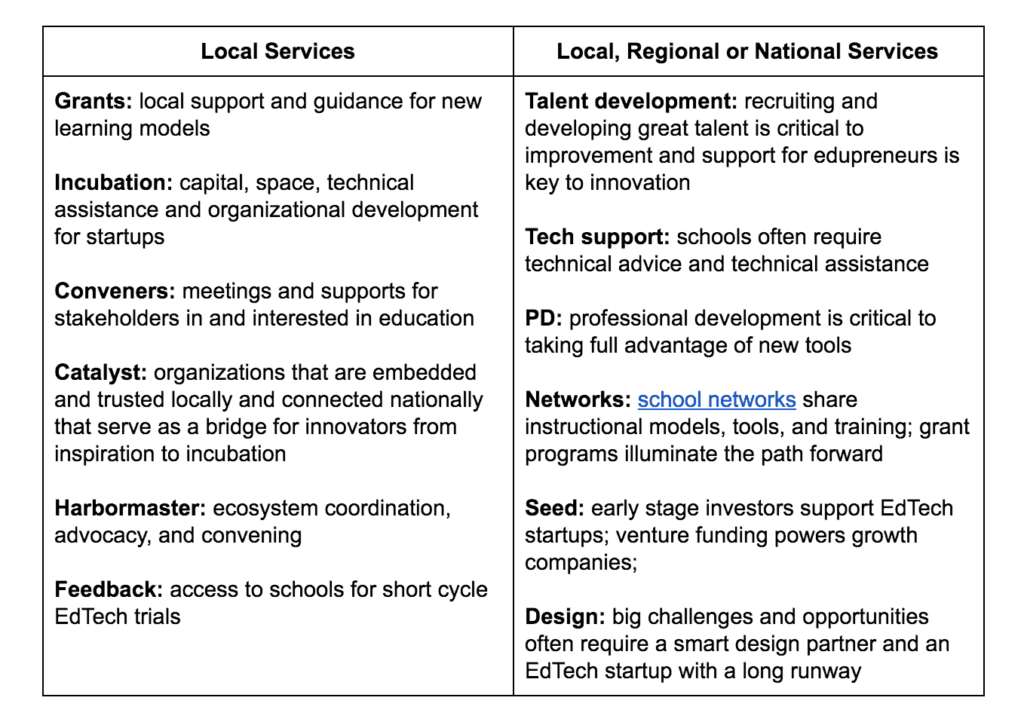Inspiration, Incubation, Intermediation: Keys to Smart Cities

Now that the majority of the world’s populations lives in sprawling cities, improving livability, workability and sustainability is a global priority.
The Smart Cities Council is focused on this challenge. Their Washington, D.C., gathering dubbed Smart Cities Week kicks off today with a star-studded list of speakers who will take up inequity, innovation and the Internet of things.
It’s hard to talk about livable, workable and sustainable communities without talking about formal and informal learning opportunities. Exponential technology makes “skilling up” a key priority for Smart Cities.
 Earlier this month we discussed the emerging smart manufacturing revolution. “For regions that skill up for the revolution, that will mean hundreds of small, nimble, high-tech manufacturing facilities with a few highly trained, well-paid staff members.” Only regions that make a commitment to a strong system of education and training will be able to take advantage of the shift to clean local manufacturing.
Earlier this month we discussed the emerging smart manufacturing revolution. “For regions that skill up for the revolution, that will mean hundreds of small, nimble, high-tech manufacturing facilities with a few highly trained, well-paid staff members.” Only regions that make a commitment to a strong system of education and training will be able to take advantage of the shift to clean local manufacturing.
As the majority of the world’s population becomes urban, cities must become centers of learning for young and old. Every person, organization and region needs to get smart—to skill up, learn more and build new capacities faster and cheaper than ever. In the long run, education is the economic development agenda. That’s the conclusion we reached after studying innovations in learning for two years.
Since being elected mayor of Sacramento in 2008, Kevin Johnson’s mission has been to make Sacramento “a city that works for everyone.” Borrowing on his mission, our book is called Smart Cities That Work for Everyone. It outlines how innovative new tools and schools are making it possible for individuals, organizations and cities to boost learning outcomes.
The Seven Key Attributes of Smart Cities
Smart Cities start with a handful of people with innovation mindsets–a combination of persistence, entrepreneurship and a collaborative focus on impact. They promote inspiration, investment and a thick layer of intermediation (design and support services). We’ve identified seven key attributes of Smart Cities:

1. Innovation Mindset. Innovation starts with a mindset–one that can be cultivated in a classroom and across a city. By adopting mindsets emphasizing growth, maker and team, leaders can promote effort, initiative and collaboration. Read more from guest contributor Matt Candler, CEO of 4.0 Schools: An Educator’s Lean Startup Mindset

2. Sustained leadership. Strong leaders challenge the status quo, build trust, generate commonly owned plans and create momentum. To sustain growth, leaders find the right balance between improvement (doing things better) and innovation (doing things differently). Educators, policymakers, investors and advocates alike can lead together to create a portfolio of quality options. Leadership development guru Lyle Kirtman writes about Innovation Leadership.

3. Talent Development. Like students, educators deserve learning opportunities that are blended, personalized and competency-based. Preparation for complex roles like teaching and leading requires a progressive sequence of work experiences combined with personalized learning. Karen Cator, President and CEO of Digital Promise, writes about Building a National Innovation Partnership.

4. Collective Impact. Innovation at scale requires stakeholders to create partnerships to work together to solve problems. This includes forming a common agenda, shared measurement systems, mutually reinforcing activities and continuous communication. Nick Donohue, CEO of the Nellie Mae Education Foundation, writes about What Would Real Engagement Look Like?

5. Aligned Investment. Education funding from early learning to higher education should be weighted, flexible, portable and performance-based. Funding alliances, like regional NGLC funds, should support new tools and schools and must be built around shared goals. Guest contributor Stacey Childress asserts It’s Time: Connecting What Students Need & What Entrepreneurs Create.
 6. New Tools and Schools. Cities should support the development of new and transformed schools along with the creation of new tools. An ecosystem of capable partners helps to incubate, invest and incentivize. Every city won’t be an EdTech hotspot, but every city needs an innovation agenda.
6. New Tools and Schools. Cities should support the development of new and transformed schools along with the creation of new tools. An ecosystem of capable partners helps to incubate, invest and incentivize. Every city won’t be an EdTech hotspot, but every city needs an innovation agenda.
7. Advocacy and Policy. Strategic advocacy and policy promote skilling-up and starting up. Policies need to be  rewritten around next-gen learning, and may require sunsetting current education code. States and districts should adopt weighted student funding to improve services to underserved learners. Read guest contributor Joanne Weiss’ post: Policymaking and Innovation Mindsets
rewritten around next-gen learning, and may require sunsetting current education code. States and districts should adopt weighted student funding to improve services to underserved learners. Read guest contributor Joanne Weiss’ post: Policymaking and Innovation Mindsets
The layer of inspiration, incubation and intermediation between schools and EdTech entrepreneurs is what will expand access to innovative learning environments and create aggregated demand for investment and new tools–and fuel the learning revolution.
Following is a summary of the supports we found in healthy learning ecosystems.

For more, see:
For recent stories on cities making progress see:
- New Schools Flourish in Phoenix
- Fulfilling an Urban Promise in Oakland
- How Houston Schools Are Making it a Great Global City





Tom Vander Ark
Interesting tidbit: India has 69 cities >1m population compared to 10 in the US
Tom Vander Ark
China has 160 cities >1m pop